Promising a return to a Norman Rockwell-esque past where everyone had great jobs, financial stability and a shot at the American dream makes for great politics, but terrible economic policies. The current and last U.S. presidents, perhaps recalling an economy from their glory years, are both guilty of this. Donald Trump ran on the explicit promise to “Make America Great Again” by reducing dependence on international trade and re-shoring manufacturing. Joe Biden also lets nostalgia guide his economic policies, which attempt to bring back the glory days of unions while restoring an economy based in manufacturing.
The economy, though, has evolved and policies that might have worked during the heydays of our most recent presidents would have little impact now. The simple fact is that the U.S. economy is no longer dominated by manufacturing, giving way to services. The way forward means policies that lead to a more dynamic economy by making it less burdensome to start a business, allowing for different kinds of work, offering education to workers of all ages and new models of unionization that provide independent workers insurance but still lets them negotiate their own wages and hours.
We tend to idealize the economy of the past because there was more unionized manufacturing employment that provided good, stable jobs which did not require a college degree. This was in part because, after World War II, the capital stock in other countries was destroyed, meaning American manufacturing could dominate and earn a large premium it shared with its workers. But the rest of the world caught up, the global economy became more competitive and upended trade, advances in technology led to efficiencies and the premium shrunk. In 1970, manufacturing accounted for about 25% of nominal U.S. gross domestic product but had fallen to just 11% in 2020.

It may be tempting to fight these forces, especially trade and technology, and the change they bring, but doing so serves neither workers nor consumers. For consumers, it only means higher prices. And while shielding workers from global trade may benefit them in the short-run, it makes them less competitive and unable to work with new technology in the long run.
Both Presidents attempted to revive manufacturing and related jobs by using subsidies and credits. Trump’s ill-fated attempt to build a factory for Foxconn (the maker of the iPhone) in Wisconsin at great taxpayer expense proved this approach was shortsighted. Some 13,000 manufacturing jobs were promised in Wisconsin, but only 3,000 materialized, most of which went to engineers and programmers, not those left behind by trade and technology. This was not just a failure of execution; most Americans workers lack the skills and are too expensive to make the inputs Foxconn needs. This is also why the prospects for Biden’s Chips Act which aims to boost domestic semiconductor manufacturing look equally dim and more expensive.
Such efforts to revive the country’s manufacturing past do not work because they do not address the root cause of manufacturing’s decline. To be clear, American workers do have a future in making things, but what it will look like can’t be predicted and government directed, and it most definitely won’t resemble the manufacturing industry of the past. That’s because American labor is more expensive and better educated than ever, and the country’s comparative advantage is now in services and in more high-skilled manufacturing. A better use of resources is to reduce the barriers to entrepreneurship, invest in skills training for Americans of all ages and let the market determine the future of what gets made in America. Economists estimated that if the money spent on the Foxconn debacle were in the hands of entrepreneurs, 90,000 jobs would have been created instead of 3,000.
For most of the post-war era there were big advantages to building what economists call firm-specific capital, which is knowledge of how things are done at a particular company. If you worked at Ford Motor Co., it was knowledge of how cars are made at Ford, and if you worked as an office administrator, you knew how to format documents in a way that was unique for your employer. But technology has made work more similar across companies: everyone uses Microsoft Word or Google Docs. Technology also means firms can better track worker productivity. These trends mean there is less value in firm-specific capital and more in individual capital. In other words, there are bigger gains to be had building your own skill set and being a star employee.








